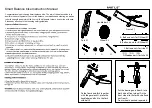
11
m)
Pedaling
Ped aling your Outlaw is the same as pedaling a traditional bicycle. It is recommended you add pedaling to the power of
the bicycle to enhance the distance per charge. The Outlaw is a 8 speed bicycle and has the ratio of a 42T front chain
ring (sprocket) against a 11-28T rear freewheel which is designed to offer an easy pedaling pace at any speed from 1
MPH to 18 MPH. It is recommended on steep inclines, the rider utilizes the throttle to assist in powering the bicycle up
the incline while simultaneously dropping the bicycle to a lower gear. If a rider’s style of riding is throttle only with no
pedaling, distance per charge will be decreased. Upon a steep incline, the rider is required to assist the motor by
pedaling to power up the incline.
n)
Shifting gears
(SEE PHOTO)
The shifting of gears is required to change the ratio of the rotation of pedaling to
allow more or less torque and lower or higher speeds according to one
complete rotation of the crank set. If requiring more torque, you will shift to a
larger rear sprocket for a higher rotation of pedaling to a lower speed of the rear
wheel. To switch to a larger rear sprocket, you will need to shift to a lower gear.
Gear 1 is the largest sprocket which is 28 Teeth and your lowest gear. One full
crank rotation creates a 1.57 turn of the rear wheel. For higher speeds from less
rotation of the crankset on flat pathways, you will shift to a smaller rear sprocket
for a higher wheel rotation to a lower crankset speed. To shift to a smaller
sprocket, you will need to shift to a higher gear. Gear 8 is the smallest sprocket
with 11 Teeth and your highest gear. One full crank rotation creates a 3.8 turn of
the rear wheel. Please review the photo on shifting gears.
o)
Watching for obstacles around you
Your new Outlaw travels at higher speeds than most riders are accustomed to, when pedaling a traditional bicycle. It is very
important you are aware of your surroundings and obstacles which may appear near you. You must watch the path surface
you are traveling on which could cause the tires to slip or cause a flat. Examples are soft shoulders, rocks, holes, uneven
paths, grates, construction sites. Due to the higher rate of speed when riding under motor power versus pedaling, objects
will advance into your path at a faster rate. Pay attention to other riders in your area, vehicles, motorcycles, pedestrians,
poles, cross paths and signs to name a few. The Outlaw resembles a traditional bicycle and people walking, driving or
standing may not realize you are on a motor powered vehicle and misjudge your traveling speed.
WARNING:
Hitting a pot hole, soft shoulder or other road deviation may cause you to lose control, be
thrown and cause serious injury or death.
p)
Safe riding in various conditions
Riders may find themselves riding in a condition they did not plan on encountering. It is important your new Outlaw is
maintained properly for optimum performance. Please read Chapter 7 on the details required to keep your electric bicycle at its
best. An unexpected rain storm, snow flurry or night ride could arise during a day’s trip and you should always be prepared.
Please read Chapter 4 on Safety, so upon encountering an unexpected riding condition, you will be confident and ready.
q)
Charging your battery
The Outlaw
’s battery system is the safest and latest technology in Lithium Ion battery cells and was designed to be easily
charged. Chapter 8 offers a detailed explanation on battery management but the following information is a basic guide in
charging your battery. The battery is a removable device and can be charged on or off the bicycle. If removing the battery
to charge it, please follow these instructions.
Locate the key ignition on the battery and turn the key in a counter clockwise rotation to the
―UNLOCK‖
position.
You must push the key in to turn from the ―OFF‖ position to the ―UNLOCK‖ position.
Grab the handle at the back of battery and carefully pull towards the back of the bicycle to slide off.
The battery is now transportable and can be charged away from the bicycle
when in ―UNLOCK‖ position.
For charging, please review the following instructions.
Locate the RCA charging input at the front of the battery and open the charger input cover.
Insert the charging plug from the
charger into the battery’s RCA charging input.
Insert the
charger’s power cord into a wall outlet.
T
he charger’s LED light will light RED while the charger is charging the battery.
The
charger’s LED light will light GREEN upon the battery being fully charged.
There is also a battery indicator for checking a full charge. Press the indicator button to di
splay the battery’s
energy storage. The indicator is located on top of the battery.
Once the battery is fully charged, you should discontinue charging and remove the charger.
Unplug the
charger’s power cord from the wall and remove the charging plug from the battery.
You are ready to install the battery pack back onto your bicycle.
To install the battery, first align the bottom of the battery with the battery base rail.
Once aligned, slide the
battery firmly into the battery base and until the battery base terminals insert into the
battery’s terminal outlets. The battery’s locking slots must slide properly onto the mount’s 3 metal tabs.
Once the battery is properly slid into place, you can then turn the key to the ―ON‖ position.
The LEDs on the thrott
le in the ―ON‖ position will display a charged battery’s
energy capacity.












































